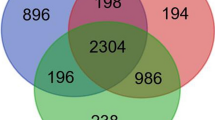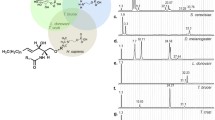Abstract
Leishmaniasis is a widespread parasitic disease principally treated by intravenous drugs. Hexadecylphosphocholine (miltefosine) has recently proved its efficacy by oral route. Although its mechanism of action has been investigated, and principally relies on perturbations of the metabolism of lipids and especially phospholipids, further studies need to be conducted to detect precisely which metabolic pathways are impacted. For this purpose, the present work proposes a complete lipidomic study focused on membrane phospholipids of clones of Leishmania donovani non-treated (NT), treated (T) and resistant (R) to miltefosine. Firstly, a separation of phospholipids in normal phase high-performance liquid chromatography (NP-HPLC) was coupled to a mass spectrometer (MS) equipped with an electrospray (ESI) ion source, and response was compared to evaporative light scattering detection (ELSD). Secondly, a quantification of phospholipid classes was performed using NP-HPLC/ESI/MS on NT, T and R clones of L. donovani. Thirdly, full-scan acquisitions of analyzed samples were compared using orthogonal signal correction-partial least square-discriminant analysis (OSC-PLS-DA) to highlight phospholipid molecular species of interest between the three types of clones. Structural determination of the most relevant species has finally been performed using tandem mass spectrometry. A first hypothesis on the effect of miltefosine on lipid metabolic pathways is then proposed.









Similar content being viewed by others
References
WHO | Leishmaniasis: background information
Chappuis F, Sundar S, Hailu A, Ghalib H, Rijal S, Peeling RW, Alvar J, Boelaert M (2007) Visceral leishmaniasis: what are the needs for diagnosis, treatment and control? Nat Rev Microbiol 5:873–882
Maltezou HC (2010) Drug resistance in visceral leishmaniasis. J Biomed Biotechnol 2010:617–521
Croft S, Neal R, Pendergast W, Chan J (1987) The activity of alkyl phosphorylcholines and related derivatives against Leishmania donovani. Biochem Pharmacol 36:2633–2636
Croft SL, Snowdon D, Yardley V (1996) The activities of four anticancer alkyllysophospholipids against Leishmania donovani, Trypanosoma cruzi and Trypanosoma brucei. J Antimicrob Chemother 38:1041–1047
Kuhlencord A, Maniera T, Eibl H, Unger C (1992) Hexadecylphosphocholine: oral treatment of visceral leishmaniasis in mice. Antimicrob Agents Chemother 36:1630–1634
Sundar S, Rosenkaimer F, Makharia MK, Goyal AK, Mandal AK, Voss A, Hilgard P, Murray HW (1998) Trial of oral miltefosine for visceral leishmaniasis. Lancet 352:1821–1823
Jha T, Sundar T, Thakur C, Bachmann P, Karbwang J, Fischer C, Voss A, Berman J (1999) Miltefosine, an oral agent, for the treatment of Indian visceral leishmaniasis. N Engl J Med 341:1795–1800
Rakotomanga M, Loiseau PM, Saint-Pierre-Chazalet M (2004) Hexadecylphosphocholine interaction with lipid monolayers. Biochim Biophys Acta 1661:212–218
Rakotomanga M, Blanc S, Gaudin K, Chaminade P, Loiseau PM (2007) Miltefosine affects lipid metabolism in Leishmania donovani promastigotes. Antimicrob Agents Chemother 51(4):1425–1430
Zhang K, Beverley SM (2010) Phospholipid and sphingolipid metabolism in Leishmania. Mol Biochem Parasitol 170:55–64
Peterson BL, Cummings BS (2006) A review of chromatographic methods for the assessment of phospholipids in biological samples. Biomed Chromatogr 20:227–243
Christie W (1985) Rapid separation and quantification of lipid classes by high performance liquid chromatography and mass (light-scattering) detection. J Lipid Res 26:507–512
Christie WW (1986) Separation of lipid classes by high-performance liquid chromatography with the “mass detector”. J Chromatogr 361:396–399
Stolywho A, Martin M, Guiochon G (1987) Analysis of lipid classes by HPLC with the evaporative light-scattering detector. J Liq Chromatogr 10:1237–1253
Vandermeeren P, Vanderdeelen J, Huys M, Baert L (1988) Simple and rapid method for high-performance liquid-chromatographic separation and quantification of soybean phospholipids. J Chromatogr 447:436–442
Breton L, Serkiz B, Volland J, Lepagnol J (1989) A new rapid method for phospholipid separation by high-performance liquid-chromatography with light-scattering detection. J Chromatogr 497:243–249
Becart J, Chevalier C, Biesse J (1990) Quantitative-analysis of phospholipids by HPLC with a light-scattering evaporating detector—application to raw-materials for cosmetic use. J High Resolut Chromatogr 13:126–129
Godoy Ramos R, Libong D, Rakotomanga M, Gaudin K, Loiseau PM, Chaminade P (2008) Comparison between charged aerosol detection and light scattering detection for the analysis of Leishmania membrane phospholipids. J Chromatogr A 1209:88–94
Díaz-López R, Libong D, TsapisN FE, Chaminade P (2008) Quantification of pegylated phospholipids decorating polymeric microcapsules of perfluorooctyl bromide by reverse phase HPLC with a charged aerosol detector. J Pharm Biomed Anal 48:702–707
Nair LM, Werling JO (2009) Aerosol based detectors for the investigation of phospholipid hydrolysis in a pharmaceutical suspension formulation. J Pharm Biomed Anal 49:95–99
Pulfer M, Murphy RC (2003) Electrospray mass spectrometry of phospholipids. Mass Spectrom Rev 22:332–364
Carrasco-Pancorbo A, Navas-Iglesias N, Cuadros-Rodríguez L (2009) From lipid analysis towards lipidomics, a new challenge for the analytical chemistry of the 21st century. Part I: modern lipid analysis. Trends Anal Chem 28:263–278
Navas-Iglesias N, Carrasco-Pancorbo A, Cuadros-Rodríguez L (2009) From lipid analysis towards lipidomics, a new challenge for the analytical chemistry of the 21st century. Part II: analytical lipidomics. Trends Anal Chem 28:393–403
Evans GA (2000) Designer science and the “omic” revolution. Nat Biotechnol 18:127
Romero R, Espinoza J, Gotsch F, Kusanovic JP, Friel LA, Erez O, Mazaki-Tovi S, Than NG, Hassan S, Tromp G (2006) The use of high-dimensional biology (genomics, transcriptomics, proteomics, and metabolomics) to understand the preterm parturition syndrome. BJOG 113:118–135
Oldiges M, Lütz S, Pflug S, Schroer K, Stein N, Wiendahl C (2007) Metabolomics: current state and evolving methodologies and tools. Appl Microbiol Biotechnol 76:495–511
Lu X, Xu G (2008) Biomarker methods in drug discovery and development. Humana, Totowa, NJ
Eriksson L, Antti H, Gottfries J, Holmes E, Johansson E, Lindgren F, Long I, Lundstedt T, Trygg J, Wold S (2004) Using chemometrics for navigating in the large data sets of genomics, proteomics, and metabonomics (gpm). Anal Bioanal Chem 380:419–429
Yetukuri L, Ekroos K, Vidal-Puig A, Oresic M (2008) Informatics and computational strategies for the study of lipids. Mol Biosyst 4:121–127
Balgoma D, Montero O, Balboa MA, Balsinde J (2010) Lipidomic approaches to the study of phospholipase A2-regulated phospholipid fatty acid incorporation and remodeling. Biochimica 92:645–650
Postle AD, Wilton DC, Hunt AN, Attard GS (2007) Probing phospholipid dynamics by electrospray ionisation mass spectrometry. Prog Lipid Res 46:200–224
Maréchal E, Riou M, Kerboeuf D, Beugnet F, Chaminade P, Loiseau PM (2011) Membrane lipidomics for the discovery of new antiparasitic drug targets. Trends Parasitol. doi:10.1016/j.pt.2011.07.002
Milne S, Ivanova P, Forrester J, Alex Brown H (2006) Lipidomics: an analysis of cellular lipids by ESI-MS. Methods 39:92–103
Sedmak JJ, Grossberg SE (1977) A rapid, sensitive and versatile assay for protein using Coomassie brilliant blue G250. Anal Biochem 79:544–552
Folch J, Lees M, Sloane Stanley GH (1957) A simple method for the isolation and purification of total lipids from animal tissues. J Biol Chem 226:497–509
Katajamaa M, Miettinen J, Oresic M (2006) MZmine: toolbox for processing and visualization of mass spectrometry based molecular profile data. BMC Bioinformatics 22:634–636
Wold S, Antti H, Lindgren F, Öhman J (1998) Orthogonal signal correction of near-infrared spectra. Chemom Intell Lab Syst 44:175–185
Eriksson L, Johansson E, Kettaneh-Wold N, Trygg J, Wikström C, Wold S (2006) Multi- and megavariate data analysis part I: basic principles and applications. Umetrics, Umea, Sweden, pp 267–296
Wiklund S, Johansson E, Sjostrom L, Mellerowicz EJ, Edlund U, Shockcor JP, Gottfries J, Moritz T, Trygg J (2008) Visualization of GC/TOF-MS-based metabolomics data for identification of biochemically interesting compounds using OPLS class models. Anal Chem 80:115–122
Hsu F, Turk J (2009) Electrospray ionization with low-energy collisionally activated dissociation tandem mass spectrometry of glycerophospholipids: mechanisms of fragmentation and structural characterization. J Chromatogr B Anal Technol Biomed Life Sci 877:2673–2695
Zheng L, T’Kindt R, Decuypere S, Freyend SJV, Coombs GH, Watson DG (2010) Profiling of lipids in Leishmania donovani using hydrophilic interaction chromatography in combination with Fourier transform mass spectrometry. Rapid Commun Mass Spectrom 24:2074–2082
T’Kindt R, Scheltema RA, Jankevics A, Brunker K, RIjal S, Dujardin JC, Breitling R, Watson DG, Coombs GH, Decuypere S (2010) Metabolomics to unveil and understand phenotypic diversity between pathogen populations. PLoS Negl Trop Dis 4(11):e904
Hsu F, Turk J, Zhang K, Beverley SM (2007) Characterization of inositol phosphorylceramides from Leishmania major by tandem mass spectrometry with electrospray ionization. J Am Soc Mass Spectrom 18:1591–1604
Dorlo TPC, Hillebrand MJX, Rosing H, Eggelte TA, de Vries PJ, Beijnen JH (2008) Development and validation of a quantitative assay for the measurement of miltefosine in human plasma by liquid chromatography–tandem mass spectrometry. J Chromatogr B 865:55–62
Acknowledgments
Françoise Huteau and Sandrine Cojean are acknowledged for their kindly technical assistance in L. donovani cultures. Cynthia Mongongu (Analysis Department of the French Agency for Doping Control) is acknowledged for her technical support on fragmentation studies. This work was supported by The ALBAN Program of European Union Program of High Level Scholarships for Latin America through scholarship No.E04D044940CL; and by MECESUP Project UCO 0202 of Ministry of Education and University of Concepción, Chile.
Author information
Authors and Affiliations
Corresponding author
Rights and permissions
About this article
Cite this article
Imbert, L., Ramos, R.G., Libong, D. et al. Identification of phospholipid species affected by miltefosine action in Leishmania donovani cultures using LC-ELSD, LC-ESI/MS, and multivariate data analysis. Anal Bioanal Chem 402, 1169–1182 (2012). https://doi.org/10.1007/s00216-011-5520-3
Received:
Revised:
Accepted:
Published:
Issue Date:
DOI: https://doi.org/10.1007/s00216-011-5520-3




